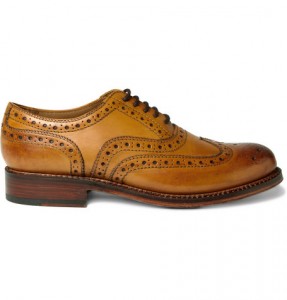 Do you remember the 1990s? It was a decade of change; serious social and sartorial paradigm shifting – to use a very ‘90s term. Back then, the rules which governed the very concept of business attire and professional decorum were being tossed out the window wholesale.
Do you remember the 1990s? It was a decade of change; serious social and sartorial paradigm shifting – to use a very ‘90s term. Back then, the rules which governed the very concept of business attire and professional decorum were being tossed out the window wholesale.
Prior to the dot-com revolution, suits were de rigueur in most offices and the concept of “corporate casual” had not yet been birthed; at least not in the mainstream workplace. As the internet revolution gained steam and started to impact how we did business and even thought about business, our work wardrobes too began to change.
As they shuffled to the closet each morning, men started to pine for the glories of casual comfort. Just like those Silicon Valley guys who seemed to be living the real American Dream, lawyers and accountants, statisticians and bureaucrats all started to ask for work wear flexibility. This was the beginning of a sartorial revolution that, ironically, would lead full-circle to the current resurgence of dressing up and dressing well.
Remember the young hotshot exec in those 1998 Westin Hotel TV spots who was so successful that he got away with wearing jeans to the office? Scandalous! That was big stuff back then. He was a rock star.
As I have noted before, the resurgence in men’s interest in fashion, personal style and for some, a near-obsession with quality and heritage, is largely due to the current generation looking to their parents for guidance and instead seeing 50 year-old college wanabes.
Today’s 20 and 30 year-olds are rebelling against their parent’s generation because, basically, they are kind of slobs. Not only do many of today’s dads have little personal style, they also deign to find value in things that even sniff of vanity or taste.
The generation that matured under the influence of grunge music, Old Navy as office wear and a cultural rejection of “corporate influence” was groomed to treat any interest in style as effeminate and undesirable. To them, the coat and tie was a yoke of bland depersonalization. It was the embodiment of the “uniform” in all of its negative context.
Truth be told, this was a pretty accurate characterization.
 By the late 1980s and throughout the 1990s, office wear was, for the most part, boxy and bland, uninspired and uninspiring. The cool kids wore jeans and Chuck Taylor’s to the office. They had messenger bags and messy hair. They worked in California. They were smart, ironic and edgy and, most importantly, they were individuals.
By the late 1980s and throughout the 1990s, office wear was, for the most part, boxy and bland, uninspired and uninspiring. The cool kids wore jeans and Chuck Taylor’s to the office. They had messenger bags and messy hair. They worked in California. They were smart, ironic and edgy and, most importantly, they were individuals.
They expressed individualism through nonconformity and discarding the sartorial symbols of traditional work. To them, what they did mattered, not what they wore. Sartorial rebellion was their visible call to arms. Of course, such things are never so simple: by dressing in a deliberately rebellious and nonconformist fashion, they were themselves creating a new degree of conformity. Dressing outside the cultural boundaries of the new code (i.e., dressing up) risked exclusion and social derision.
Fast forward to today and we have a near opposite situation. What had then been new and fresh, innovative and freeing rapidly turned into an excuse to wear sweatpants to the office. All those amazing perks that went along with the relaxed dress code – game rooms, personal concierge service, loaner Porches, company-provided grocery shopping and dog walking – all went away with the collapse of the dot.com bubble. That pesky profitability thing just ruined it all.
However, the casual wardrobe stuck in there. It was seen as anachronistic and unnecessary to once again don a tie or suit if you did not absolutely have to do so. “Why does it matter” was the thought. Work and results were the point, not how you dressed. To be sure, there was some retrenching on dress codes, but it was largely confined to traditionally formal environments like law and corporate offices.
While the dot.com implosion dented casual office wardrobes, it had not totally invalidated the concept. Khakis and polo shirts persisted. In the eyes of some though, lack of “appropriate” office dress belied a deeper cultural issue: a lack of respect and accountability for one’s self and work. This viewpoint is often tied to professions in which earning a client’s confidence is vital (why should I entrust my fortune to a banker in a tee shirt or my international merger to some kid dressed for golf?).
 As the economy picked up through the mid-2000s and a new generation of hotshots started looking for ways to express both their financial success and – here’s that word again – individuality, many turned not to their pleated and over sized polo-clad parents, but to each other.
As the economy picked up through the mid-2000s and a new generation of hotshots started looking for ways to express both their financial success and – here’s that word again – individuality, many turned not to their pleated and over sized polo-clad parents, but to each other.
Through revolutionary blogs like Scott Schuman’s Sartorialist, guys saw how to dress with genuine style and flair. Real people with real taste; not a runway or catalog or magazine but the streets of New York. And sites like the one you are now reading, Andy Gilcrest’s Ask Andy (the founding father of menswear blogs) and Will Boehlke’s A Suitable Wardrobe, provided the kind of detailed sartorial and style information simply not previously available.
This up-and-coming generation of young men took it upon themselves to learn about the history of men’s style, its variations and traditions. Most importantly, they started to talk about it with each other. Bypassing their parent’s generation altogether, the inspiration we now see comes from the golden ages of menswear: the 1920s through 1950s.
The success of TV’s Mad Men has also awakened a belated appreciation of 1960s streamlined, swanky, cocktail-swilling manliness. An entire subculture has developed, fixated on analyzing the remarkable period execution of the show’s producers and set dressers.
With all this as a cultural backdrop, more blogs began popping up and more Sartorialist-inspired photographers began posting examples of outfits and clothing details. When OTC first launched six years ago, it was one of perhaps five menswear-focused blogs. Now there are scores, covering all aspects of men’s fashion. Some come and go; some last. Some are shallow vanity projects with nothing of substance to offer anyone. Others, like the innovative Put This On blend video shorts with clever and genuinely practical advice.
The audiences for these sites continue to grow. And it’s not just Wall Street I-bankers looking for the right Rolex. Many of these men want a detailed understanding of proper suit construction, the differences between mechanical and automatic watch movements, the provenance of a Ghurka briefcase or the hallmarks of a handmade shoe.
When the crash of 2008 tore the confidence and pay checks from massive swaths of the population, an interesting thing happened. As expected, a degree of formality and sobriety returned to many workplaces. Some companies chose to reestablish guidelines for work attire; some tightly defining office casual and others requiring traditional business dress.
The reaction among menswear and style bloggers was not to rise up against conformity but to double down. They demanded from each other and the fashion world more choices, greater quality, customization and the rediscovery of, for lack of a better term, dandyism. And while sites like IVY STYLE revel in the joys of East Coast preppy culture (incredibly popular in its own right), not all influencers have their gaze set to the rear view mirror.
 For some of these bloggers, taking classic style traditions and breathing into them new life is a goal in and of itself.
For some of these bloggers, taking classic style traditions and breathing into them new life is a goal in and of itself.
Last year, I organized a blogger meet-up for Alan Flusser, the noted menswear designer and author who created Gordon Gecko’s wardrobe for the movie Wall Street. Normally accustomed to captains of industry and fashion royalty, his audience that night consisted of young menswear bloggers; a new generation looking to blend traditional style with modern sensibilities. It was eye opening.
Street Etiquette is a leading example of this classic/urban hybrid which is powering much of the interest in menswear. Joshua Kissi and Travis Gumbs, who both attended the Flusser event, are seriously influential guys with creative, detail-oriented points of view.
Alan is adapting to this new generation’s sensibilities. Recently revamping his showroom to reflect a cleaner, Art Deco feel and tweaking his house silhouette a bit, he understands that the influencers of today are less likely to be him, and more his kids’ peers. Nonetheless, he and other fashion luminaries like G. Bruce Boyer are not sitting still, reflecting in their past glories.
Still influential and still sartorially authoritative, Alan’s innovative iPhone apps, BeSpeak and Snap Dress, are backed by complex algorithms which attempt to mimic his vast depth of knowledge. They allow users to create truly customized wardrobe choices matched to their specific body and coloration profiles. Alan Flusser in your pocket, as it were.
 Just take a tour of the websites and blogs dedicated to men’s fashion and style and you’ll find a master’s degree worth of examples in branding, content management, writing, photography and retailing.
Just take a tour of the websites and blogs dedicated to men’s fashion and style and you’ll find a master’s degree worth of examples in branding, content management, writing, photography and retailing.
I’ve lost track of the number of former bankers who have reached out to OTC to tell me about their custom suit, shirt or tie making venture. For some, it’s all business and they see a market in dressing well. For others, frankly more than I had expected, it’s a real desire to express a deep interest in helping people be their best.
Big names like MR PORTER, the men’s division of NET-A-PORTER, combine retail flash sales with blog-worthy content. Akin to a newspaper with its features and product write-ups, it’s clear that the site’s backers understand the single most important thing about getting a guy’s interest in fashion piqued: content.
For men, content is king and context is a close runner up. And that is one of the great levelers brought by the internet to this debate; it democratized the issue of fashion and the relevance of style. The blogs and sites which have succeeded and continue to wield influence present something useful and relevant. They give their readers something worth reading, content with value and the historical and style-focused context to help put it all into perspective.
Hopefully, this installment provides just that.

Chris,
Excellent post – I really enjoyed reading through it and wondering where my businesses fit in to the time line. Having only been in the industry since 2007 – it’s been amazing to watch it change and evolve in just 4 short years. I also agree with you that content is king – although if you can master both content and design you’re almost guaranteed to build a loyal audience.
Now you need to write about the future and where you think it’s headed – maybe some commentary on how some of the larger brands can leverage the talent out there and will we ever see a forum or blog acquired by a brand for marketing/sales purposes (vs. many of the poor attempts to build their own in house).
R/S
Antonio
This is a very interesting post. The first hints for a history, as it were. Now, a few remarks: 1. Apparently, most bloggers do have their sights on Wall Street Bankers (A suitable Wardrobe, Permanent Style, Welldressed, TheLondonlounge, etc. etc.) Honestly, who might otherwise be these guys who could afford buying solely bespoke shoes at John Lobb (London), Foster & Son, Cleverly, Bontini, Vass, Edward Green, etc.? Or their tweed suits at Huntsman? 2. Street Etiquette has a very different and specific audience in sight, and is focused on their needs. 3. Lots of guys like myself still do not find the right blog that exclusively cares for their needs. Hence, we spend our time jumping from one blog to the other, and often end up disappointed by the type of information delivered. The Sartorialist, eventhough interesting is not enough gender specific, and sweep too broadly. I nonetheless like browsing through – among others – Permanent Style for one reason: indeed, even if Simon, say, seems to be obsessed by the city chaps, he is nonetheless very opened to queries coming from other corners of the world. He usualy replies very politely, as many others do, but the leaning tilt undoubtedly toward Wall Street. So you guys, a little bit social innovation is still in need!
Antonio – Thanks so much for the comment. Excellent idea about examining where this is all heading – at least from my perspective.
N. Martin – An excellent observation, and quite true. Many of the blogs I highlighted for this article are focused either on the suit-wearing crowd or those who enjoy debating the number of stitches in a buttonhole.
That said, sites like A Continuous Lean or Alex Grant offer a more everyday focus to their content. The interesting thing about this democratization of fashion is that it has allowed people to focus with intensity on only the very thing they love the most.
A good sight will be edited by someone with a broad spectrum of interests and open to learning about, and writing about, new things or at least a new perspective.
Ugh, I really hate this blog. While this blog may be called Off the Cuff, you have to be able to substantiate your claims (“rebelling kids,” “slobs,” etc.). When in fact, fashion designers are quite taken aback by how this generation of 20 to 30 year olds are actually embracing style — unlike, believe it or not, their baby-boomer parents who invited casual Friday, and have turned it into a “every day” of the week endeavor. So, why would they rebel against their parents who actually are/were slobs?
So, before you go ahead and delete this comment, maybe keep it up for an open discussion.
LG is right about the Boomers.
LG – Thanks very much for the comment, I have no intention of removing it and actually enjoy the back and forth. Sorry that you hate the blog, though I’m not sure why. That said, thank you for taking the time to read the article and comment.
First, this is a blog, so that means, technically, I don’t have to substantiate anything. It’s my opinion. You made your own very specific claim about kids, their influence and fashion designers but I’m not asking you to cite corroborating data. It’s your take on things and that’s fine. But I like to try and be as useful and substantive as possible; so, here we go.
I’m a little confused because from what I can tell, we are saying exactly the same thing. The 20 and 30 year-olds of today looked to their parents sense of style (the Boomers) and saw only sloppy, casual, informal duds. Wanting to embrace and explore real style and well-made clothing these kids took it upon themselves to embrace and promote classically inspired style.
That’s the rebelling of which I speak; turning away from “every day is casual Friday,” embracing a more mature and elegant approach to dressing and making it their own.
Slobs = parents without much interest in dressing well and associated lifestyle.
Rebelling kids = 20-30 year-olds turning away from casual Friday casual and taking it upon themselves to rediscover haberdashery and dressing well.
And yes, you are correct that the fashion establishment was caught off guard by this trend. They are chasing the demands of their customers, not telling the customers what they should want. The customer already knows what he wants. That is partially the power of social media and blogs; providing the tools and information for people to educate themselves and make their own decisions.
So, therein lies my confusion: you apparently hate the blog, but just concurred with the whole point of the article.
What a great tour d’horizon. Gives me a lot to think about on a topic that, while esoteric, is nevertheless worthy of thought.
I really wonder whether this piece doesn’t signal the beginning of a turning point in blogging on men’s style and fashion. Wait and see.
Ben – Thanks for the kind words. It’s sort of like a sociological spiderweb when you start to look at all the forces and influences. Lots of fun.
N. Martin – I agree. As a blogger, and someone with a slight behind-the-scenes take on things, I think the menswear blogging space is definitely changing and evolving.
To some extent, that always portends a degrading in quality – flash over substance. But when it comes to men’s fashion and blogging, I think the impact of men caring less about who’s wearing what, and more about who made what and how, will ensure a continued focus on real content and substance.
At least that’s my hope..
News – Springhill Group Florida Home Care
Thanks a lot for your time to have had these things together on this blog. Josh and that i very much appreciated your input through the articles about certain things. I know that you have quite a few demands on your own timetable and so the fact that you actually took just as much time like you did to guide people really like us by means of this article is also highly treasured.
ランバン